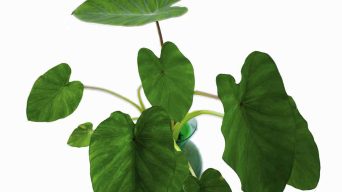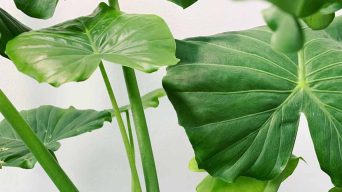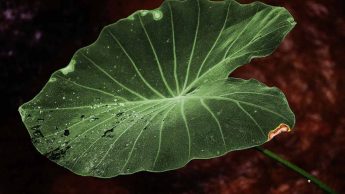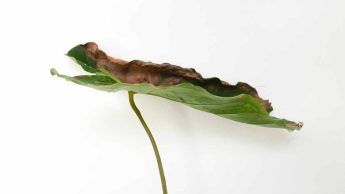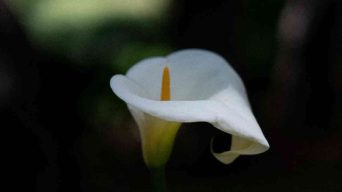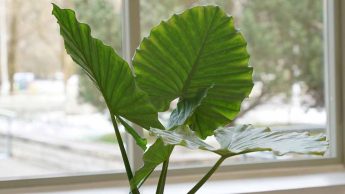Elephant ear plants may drip water due to normal processes like transpiration and guttation. Excessive dripping could signal issues like overwatering, high humidity, or temperature extremes. Adjust care, ensure proper drainage, and maintain a healthy environment to address it.
Elephant ear plants, an aesthetically pleasing touch of nature, are tropical perennials known for their big, green heart-shaped leaves. These leaves can be as large as a small house’s door panel quite often.
Native to areas of Africa, Asia, and Australia, they are plants that exhibit outside tendencies, thriving in warm, humid climates, not unlike the climates found outside in the wild. This nature stimulates an environment of high sunlight exposure, which is essential for photosynthesis, a process vital for the survival of the plant.
These plants, which can be comfortably grown both inside a house and outside in a garden, are generally easy to care for. They are not overly demanding regarding either the absorption of minerals from the soil or the light requirement.
However, just like humans, they exhibit symptoms of discomfort. The leafy plants will reveal blemished spots, which could be as small as raindrops if these needs are not met.
However, it isn’t rain that affects the elephant ear plants. Instead, the elephant ear leaves may drip water for various reasons, which could mimic a mini rain shower inside your house, and this could be a sign of concern for some plant owners. This water show is primarily due to the exit of water through tiny pores on the leaves called hydathodes.
Here, you will find all the information you need about why your elephant ear plant could be dripping water from its big leaves like a light drizzle of rain and whether it is considered normal behavior or if it’s a reason for concern.
Why Do Elephant Ear Plants Drip Water?
There are several reasons why elephant ear leaves may start to drip water. It could be due to a variety of reasons, some as large as a big change in the environment or as small as a minor temperature fluctuation.
The two most frequent reasons are transpiration and guttation.
Even though both, as regular as the sun rising and rain falling, are perfectly normal processes, they can cause concern if the water dripping is excessive, creating a small indoor rainstorm inside your house.
Transpiration
Transpiration, akin to nature’s version of sweating, is the process of water vapor escaping from a plant’s leaves. It plays a crucial role in regulating a plant’s internal temperature and preventing overheating, much like small amounts of rain can cool the hot ground.
Additionally, transpiration helps to keep the plant’s leaves moist, preventing them from drying out. It’s as if the plant brings a rain shower to itself on the inside, even if the sun is shining bright outside.
Transpiration is an essential process for all plants, and it can be particularly pronounced in elephant ears owing to its tropical origin. These climates emphasize the need for continuous transpiration, much like the need for the sun to dry the rain-soaked landscapes.
In cooler climates, where one might wish to move their elephant ear plant outside the house, transpiration rates are lower, and the water lost through this process is promptly replenished by water from the roots. This balance can be as harmonious as the sun following a rain shower.
Even in such cooler climates, elephant ear plants will still transpire, but the water lost will be replenished more rapidly. It’s as if nature, in its infinite wisdom, had designed a special sun-and-rain mechanism for these plants inside their biological system.
Can Transpiration Be Harmful?
Transpiration is a necessary process for all plants, but it can sometimes be excessive, almost like a big rainfall that just won’t stop.
If a plant loses more water than it’s taking in, much like a parched landscape under the scorching sun, it will eventually start to wilt, and the leaves will turn brown and crispy.
Excessive transpiration can be caused by several factors, including:
- Hot, dry weather
- High winds
- Low humidity
- Roots that are too dry
If you think your elephant ear plant is transpiring too much, try to increase the humidity around it, as though creating a small, private rain cloud.
This can be done by misting the leaves with water, like morning dew, or placing the pot on a tray of pebbles and water. This creates an environment that makes the water seep into the air from a small indoor source rather than an outdoor rain shower.
You should also ensure that the plant gets enough water and the roots are not allowed to dry. It’s important to think of these needs as you would the demands of living inside a house or outside in the heart of nature.
If the problem persists, you may need to move your elephant ear plant to a more humid location, maybe inside the house or in a larger, wetter outside spot.
Guttation
Guttation is the process of water droplets being secreted from the tips or edges of a plant’s leaves, not unlike rain droplets falling off the edge of a roof.
It is a normal process when the plant’s roots take in more water than the leaves can transpire, much like a big cloud that has accumulated more water than it can hold in a rain shower.
The excess water is secreted through tiny hydathodes in the leaves, and it often appears as beads of water on the tips or edges of the leaves, resembling small raindrops clinging to a leaf after a gentle rain shower.
Guttation is most common in young plants or during periods of rapid growth. This phenomenon can be observed in a variety of plants, ranging from short herbs to tall trees in your garden.
It is most common in the morning when transpiration rates are at their lowest. This is especially true if the previous night was warm and humid, and often most notable in certain regions where conditions favor significant guttation.
Guttation can also be more pronounced in plants grown in very humid conditions or watered too frequently. The mechanism behind this involves the absorption of excess water from the soil.
Can Guttation Be Detrimental to Plants?
Guttation is a normal process that occurs when a plant’s roots take in more water than the leaves can transpire. The excess water then travels up the stem to the tip of the leaves, where it is expelled.
However, it can be a cause for concern if the water droplets are excessive or if they happen frequently. Excessive guttation can lead to the plant’s leaves turning yellow or brown, a sign that your garden may require a different watering schedule.
It can also promote the growth of fungal diseases, such as powdery mildew. These diseases can take hold on trees and other large plants that are consistently damp due to guttation.
If you think your elephant ear plant is suffering from guttation, try to water it less frequently. Pay close attention to tall and short plants in your garden, as they might respond differently to changes in the watering schedule.
Ensure the pot has drainage holes so the excess water can drain away. This helps to reduce the risk of guttation in your variety of plants.
You should also increase the air circulation around the plant to help prevent the growth of fungal diseases. This mechanism can greatly contribute to the overall health of your garden plants.
If the problem persists, you may need to move your elephant ear plant to a drier location. This tip applies not just to elephant ear plants but to all kinds of plants suffering from excessive guttation in various regions of your garden.
Sometimes, high humidity levels can contribute to water-logging, causing potential harm to the plant’s health in terms of nutrient absorption and oxygen supply to cells.
It can be difficult to tell the difference between guttation and dew, as they appear as water droplets on the surface of the plant leaves.
How to Distinguish Guttation from Dew
There are key differences between dew and guttation. Dew is water that condenses from the atmosphere onto the leaves of a plant, forming tiny cells filled with moisture.
This typically occurs in the morning or evening when the air is cool and the plant leaves are cooler than the surrounding air. This natural form of respiration uses stomata, the tiny pores in leaves and stems, to regulate oxygen and nutrients.
Dew often forms a uniform layer of water on the leaves, whereas guttation droplets are usually smaller and more isolated. These droplets result from the expulsion of xylem sap, the water, and nutrients carried in the stem.
Dew will also disappear during the day as the air and plant leaves warm up, whereas guttation droplets will remain on the leaves until they are absorbed or evaporate.
If you notice water droplets on the leaves of your elephant ear plant, it is likely due to transpiration or guttation.
Both of these processes are normal and necessary for your indoor plant to function. They are part of the plant’s natural system to regulate its water and nutrient management.
How to Determine If Your Plant’s Water Dripping is Normal
While a bit of water on the leaves is normal, if you notice that your plant is dripping large amounts of water, it is likely an indication that something is wrong.
There are several potential causes of why an elephant ear plant drips water:
1. Overwatering
One of the most common reasons an elephant ear plant drips water is overwatering. When the soil is too wet, it can cause the plant to transpire excessively, leading to water droplets on the leaves.
If you think your Elephant ear plant is overwatered, allow the soil to dry out completely before watering again. You can also increase the amount of time between waterings.
2. High Humidity
Another potential cause of an elephant ear plant dripping water is high humidity. If the air around the plant is too moist, it can lead to excessive transpiration.
To lower the humidity around your plant, use a humidifier or place the pot on a tray of pebbles filled with water.
3. Temperature
The temperature can also affect an elephant ear plant’s transpiration rate. If the air around the plant is too hot, it can cause the plant to lose water more quickly than it can replace it.
To keep your plant from drying out, ensure the temperature around it stays between 65 and 75 degrees Fahrenheit.
4. Root Rot
Root rot is another possible cause of an elephant ear plant dripping water. This condition is caused by overwatering, resulting in the plant’s roots rotting away.
Rotten roots cannot absorb water, which can cause the plant to transpire excessively. If you think your plant has root rot, remove it from the pot, remove the affected roots, and replant it in fresh soil.
What To Do If Your Elephant Ear Plant Is Dripping Water
If you think your plant is being overwatered, you should first adjust your watering schedule, just like people adapt their plans according to weather forecasts.
Allow the ground soil to dry out completely between waterings and increase the amount of time between waterings, as one would adjust a lawn sprinkler in the dry season.
Elephant ear plants, among other types of home tree plants, need to be watered about once a week.
1. Adjust Watering Schedule
If you think your plant is being overwatered, you should first adjust your watering schedule.
Allow the soil to dry out completely between waterings and increase the amount of time between waterings.
Elephant ear plants need to be watered about once a week.
Although, during the hottest months, you might need to water your plant twice a week.
2. Increase Drainage
If you think your plant is overwatered, you can also try increasing drainage.
To do this, you can add more holes to the bottom of the pot or use a pot with better drainage.
You also have the option of growing your plant in a raised bed. This can create an optimized space for root expansion, fostering healthier environments for houseplants, as they have enough room to grow and absorb nutrients efficiently, much like how certain types of trees prefer elevated terrain.
3. Use a Well-Draining Soil
Another way to help with drainage is to use well-draining potting soil, something that plants, people, and all living things enjoy.
Proper drainage not only prevents water logging but also ensures the right amount of liquid nutrients reaches your plant’s roots, akin to a well-designed irrigation system in an agricultural area.
Elephant ear plants, in particular, thrive in a soil rich in organic matter that drains well, just like a tree’s root systems flourishing in rich, fertile ground.
Mixing in some perlite or sand with the soil is a good way to improve drainage – a crucial component in maintaining the size and health of your plant’s root system.
If you notice your houseplant continuously has water drops around its pot base, resembling dewdrops in gardens during the early morning shade, this could be an effective solution.
4. Reduce Humidity
Humidity management is another important aspect of houseplant care. If you think the humidity is too high, considering elephant plants prefer humid but not overly damp conditions, you can try to reduce it. It’s much like creating a balance of sun and shade in outdoor gardening for optimal growth.
To improve humidity conditions around your plant, you can use a humidifier or place the pot on a tray of pebbles filled with water. It mirrors techniques applied in larger gardens to retain moisture.
Attention to such details can enhance the color of the foliage and improve the health and life of your houseplant significantly.
Another helpful strategy is increasing air circulation, which can be achieved by using a fan. This not only helps regulate temperatures but also improves the plant’s general health. Much like it does in garden gardening, air circulation promotes robust growth.
5. Reduce Temperature
If you think the temperature is too high, which could result in the sagging of the elephant ear plant’s leaves, you can try to reduce it. It’s akin to relocating plants to a shady spot in the garden during intense summer heat.
To do this, you can move your plant to a cooler location or use a fan to circulate the air, ensuring it stays in a space with optimal temperatures for growth. In the great outdoors, plants are carefully relocated for the same reason, ensuring they retain their size and vibrant color.
Misting your plant with water occasionally can also help cool it down. This technique, borrowed from outdoor gardening, is especially beneficial during hot temperatures when the plant is particularly susceptible to heat stress.
6. Increase Air Circulation
If you think the air around your elephant plant is too stagnant, you can try to increase air circulation. Plants need fresh air to help them process carbon dioxide effectively and maintain their energy production – a concept that gardeners make use of in large, open gardens.
You can use a fan or open a window to do this, ensuring the carbon dioxide needed for photosynthesis is readily available. Fresh air also helps to keep the plant’s environment healthy, mirroring the breezy conditions experienced in outdoor gardens.
You can also try moving your plant to a location with more airflow, thus providing it the right space for growth. This mirrors how plants are strategically placed in outdoor gardens to ensure maximum growth and beautiful foliage color.
7. Inspect Roots
You should inspect the roots if you think your plant has root rot. In gardening, this regular check facilitates early detection.
To do this, you must remove the plant from the pot and examine the roots. Re-potting is often required in gardening when the size of the roots exceeds the pot’s capacity.
If the roots are black or mushy, they are likely affected by root rot. In the gardens, such a situation requires immediate attention and care.x
If you think your plant has root rot, you should remove the affected roots and replant the plant in fresh soil. This mirrors how gardening often requires replanting in richer earth for enhanced foliage color and plant health.
8. Cut Back on Fertilizer
If you think your plant is being overfertilized, you should reduce fertilizer, a common practice in gardens to preserve plants’ health.
Overfertilization can damage the plant’s roots and cause the plant to transpire excessively. This critical gardening concept can be used to preserve the size and the vibrant color of your houseplant.
If you think your plant is being overfertilized, you should reduce the amount of fertilizer you are using or stop fertilizing altogether. This mirrors the restraint gardeners show in large gardens, ensuring the earth isn’t overwhelmed with nutrients.
9. Remove Dead Leaves
If you notice that your plant has dead leaves, it’s important to remove them promptly.
Just as in gardening, where dead foliage is regularly trimmed away, this practice can significantly improve the overall health and appearance of your plant. Dead leaves can harbor pathogens and pests, which may ultimately damage the plant.
Identifying and addressing such issues promptly is a crucial gardening skill that can help preserve the size and health of your houseplant.
To remove dead leaves, simply cut them off at the base of the plant.
10. Treat for Pests
If you notice that your plant has pests, you should treat it as soon as possible.
Pests can cause various plant problems, including leaf damage, root damage, and excessive transpiration.
You can use various methods to treat pests, including chemical pesticides, biological controls, and traps.
You can also try to remove the pests by hand.
11. Treat for Disease
If you notice that your plant has a disease, you should treat it as soon as possible.
Diseases can cause various plant problems, including root damage, leaf loss, and stunted growth.
Treating a disease early can help prevent these problems.
Final Thoughts
Elephant ear plants are a delightful addition to any home, but understanding their care can sometimes be a mystery.
If you notice your elephant ear plant dripping water, there could be various reasons for it.
The most common causes are plant transpiration and guttation.
Plant transpiration is a natural process in which a plant releases water vapor through its green leaves.
Guttation, on the other hand, occurs when the plant releases water droplets from the tips of its leaves due to high humidity or recent watering.
For these reasons, there’s typically no need to worry.
However, if the dripping water is accompanied by signs of stress, such as wilting leaves, it’s essential to take a closer look at your plant’s care.
Ensure you’re not over or underwatering it, and check for any pests or diseases.
With a little investigation, you should be able to restore your elephant ear plant to good health in no time!


